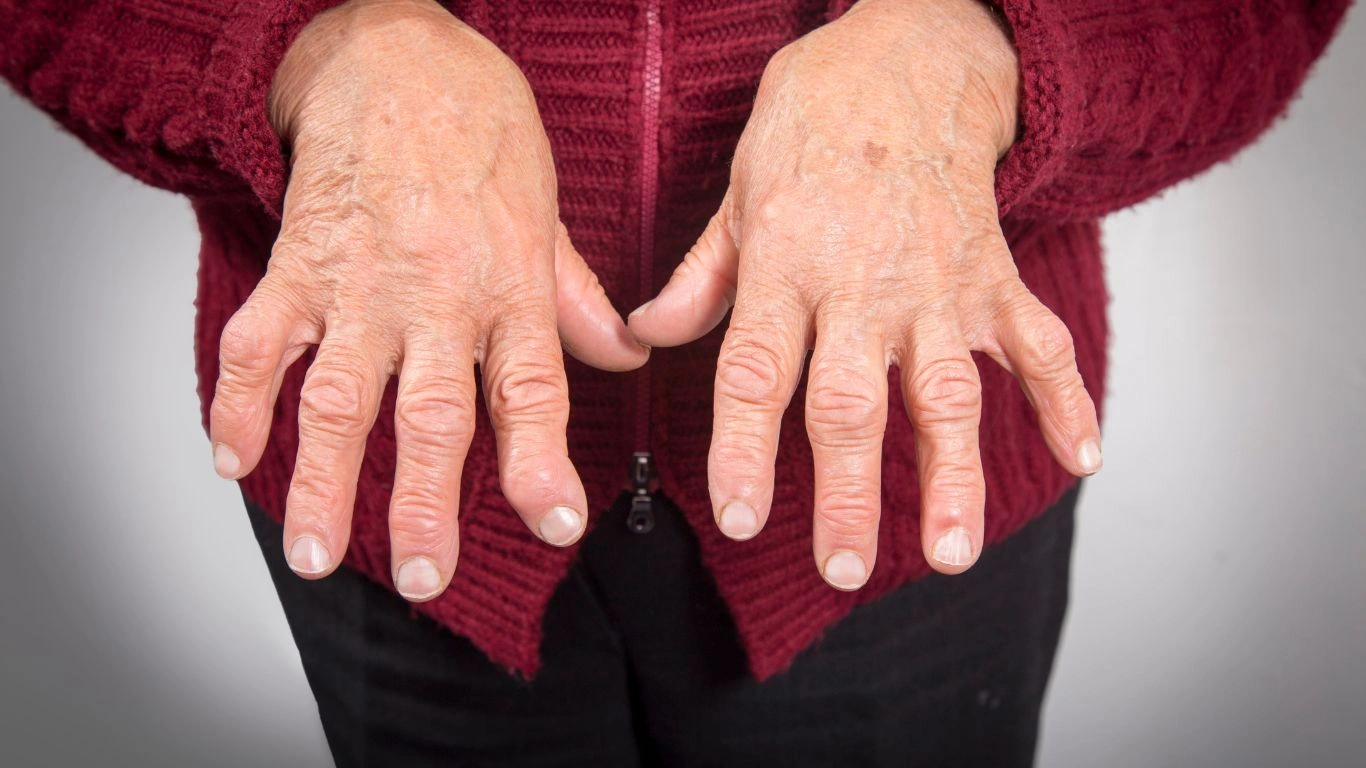Rheumatoid Arthritis & Muscle Mass: Strategies for Preservation & Strength
Rheumatoid arthritis (RA) is a chronic autoimmune disease that impacts millions of people worldwide. It primarily affects the joints, causing pain, stiffness, swelling, and eventually joint deformities. But did you know that RA’s effects go beyond the joints? One of the often-overlooked aspects of this condition is how it influences muscle mass. As someone with years of experience in managing and treating rheumatoid arthritis, I’ve seen firsthand how this disease can affect not only the joints but also the muscles.
It’s crucial for those with RA—and those who care for them—to understand how the disease can impact muscle health. In this post, we’ll take a deep dive into rheumatoid arthritis and its effect on muscle mass, discussing the physiological mechanisms, symptoms, and what you can do to combat the muscle loss that often accompanies this disease.
How Rheumatoid Arthritis Impacts Muscle Mass

Rheumatoid arthritis isn’t just about joint pain. One of the lesser-known but significant consequences of RA is muscle loss. This phenomenon is often referred to as “muscle wasting” or “sarcopenia.” The relationship between RA and muscle mass can be complicated, as several factors contribute to muscle loss in those with the disease. Let’s break it down:
Inflammation and Muscle Breakdown

At the heart of rheumatoid arthritis is chronic inflammation. The immune system mistakenly attacks the synovium (the lining of the joints), causing swelling, pain, and stiffness. This inflammation doesn’t stay confined to the joints; it can spread throughout the body. One of the consequences of systemic inflammation is the breakdown of muscle tissue.
Muscle wasting in RA patients is primarily driven by the inflammatory cytokines—small proteins released by immune cells during inflammation. These cytokines, like TNF-alpha and IL-6, signal the body to break down muscle proteins at an accelerated rate. Over time, this can result in a noticeable decrease in muscle mass. In fact, studies have shown that people with RA tend to lose muscle mass at a faster rate than the general population, even when they are not physically inactive.
Impact of Pain and Reduced Activity
Pain is a major issue for those with rheumatoid arthritis. When the joints are swollen and painful, physical activity becomes difficult, and sometimes even impossible. This lack of movement is a double-edged sword. Not only does it contribute to joint stiffness, but it also leads to muscle deconditioning. When we don’t move our muscles regularly, they begin to weaken and shrink. In RA patients, this lack of physical activity can further exacerbate muscle loss.
From my experience, it’s common for patients to become less active due to joint pain, and they may even avoid using the muscles altogether. Unfortunately, the less you use your muscles, the more likely they are to atrophy. This is why it’s so important for RA patients to work closely with a physical therapist to find a manageable, joint-friendly exercise routine. Gentle exercises like swimming or using resistance bands can help combat this issue without putting too much strain on the affected joints.
The Role of Medications in Muscle Mass Loss
Another contributing factor to muscle loss in rheumatoid arthritis is the medications used to treat the disease. While disease-modifying antirheumatic drugs (DMARDs) and biologics play a vital role in controlling inflammation and preventing joint damage, they can also have side effects that impact muscle health.
For example, corticosteroids like prednisone are commonly prescribed to reduce inflammation in RA patients. While these drugs are effective at managing symptoms, they come with a catch. Long-term use of corticosteroids can lead to a reduction in bone density and muscle mass. Corticosteroids can cause the body to retain more fat and break down muscle protein, leading to the loss of lean muscle mass over time.
Although corticosteroids are sometimes necessary, the goal is always to use them sparingly and to balance their use with other treatments to prevent long-term side effects. Working with your healthcare provider to monitor medication use is critical in minimizing muscle-related complications.
What Does Muscle Loss Mean for RA Patients?

When it comes to rheumatoid arthritis, the loss of muscle mass can have a profound impact on daily life. Muscle strength plays a crucial role in mobility, balance, and overall physical function. In individuals with RA, the loss of muscle mass can contribute to increased frailty, decreased independence, and a higher risk of falls and fractures. For those who are already struggling with joint pain and stiffness, muscle loss can add another layer of difficulty to simple tasks like walking, climbing stairs, or even getting out of bed.
In my practice, I’ve often heard patients describe how they feel weaker or more fatigued as their disease progresses. This isn’t just due to the pain; it’s often because of the gradual muscle loss they may not even be aware of. Maintaining muscle strength is crucial, as it helps not only with mobility but also with controlling pain and maintaining the health of the joints themselves.
Understanding the connection between rheumatoid arthritis and muscle mass is key to improving the quality of life for those living with RA. In the next sections, we’ll explore strategies to maintain muscle mass and prevent further loss, including exercise regimens, diet tips, and medication adjustments. But first, it’s important to remember that RA management isn’t just about reducing inflammation—it’s also about improving overall function and well-being.
Strategies to Maintain Muscle Mass in Rheumatoid Arthritis

So, how can we combat the muscle loss that often comes with rheumatoid arthritis? If you’ve been living with RA for a while, you probably know how challenging it can be to keep your muscles strong while managing joint pain and inflammation. But here’s the good news: with the right approach, you can maintain muscle mass, improve your strength, and ultimately enhance your quality of life. Let me share some strategies I’ve found helpful for my patients—and myself—over the years.
1. Regular Exercise: The Key to Preserving Muscle Mass

Exercise is often a tough sell for people with rheumatoid arthritis, especially when your joints are swollen and painful. But trust me when I say that staying active is one of the most effective ways to prevent muscle wasting. It doesn’t have to be intense workouts at the gym; even simple, low-impact exercises can do wonders for maintaining muscle mass.
The key is to focus on strength training and mobility exercises that are gentle on the joints but still challenging enough to engage the muscles. For example, resistance bands, light weights, and bodyweight exercises (like squats or modified push-ups) are great tools to keep your muscles toned. Aim for exercises that target large muscle groups—like your thighs, arms, and core—since these muscles are critical for functional strength. Also, don’t forget about balance exercises! Improving balance not only helps with stability but also strengthens smaller stabilizing muscles that might get overlooked in a typical workout routine.
One tip I often give my patients is to start slow and gradually increase the intensity. Too much too soon can lead to flare-ups, so it’s important to listen to your body. If something hurts, ease off and try a modified version or a different movement. Low-impact activities like swimming or cycling can also be great alternatives because they provide resistance without putting too much stress on your joints.
2. Consistency is Key
When you’re managing rheumatoid arthritis, it can be easy to get discouraged and stop exercising altogether, especially on days when pain and stiffness are at their worst. But consistency is essential. Even if you can only manage a few minutes of exercise at a time, those minutes add up. Over time, regular movement can help build strength, improve joint function, and even reduce pain.
From my experience, setting realistic goals is crucial for staying motivated. Maybe that means committing to a 10-minute walk every day or incorporating a short stretching session after you wake up. As you build strength, you’ll find that it becomes easier to gradually increase the intensity of your workouts. Progress may be slow at first, but don’t let that discourage you. Muscle growth takes time, and every small step you take toward maintaining muscle mass is a victory.
3. Focus on Nutrition
Exercise alone isn’t enough to preserve muscle mass. Proper nutrition plays a huge role, and it’s one area that I find many people with RA overlook. Your body needs the right fuel to repair muscles, reduce inflammation, and stay strong. Protein is especially important when it comes to building and maintaining muscle tissue.
For people with rheumatoid arthritis, getting enough protein can be a challenge, especially if pain and fatigue make it difficult to prepare meals. But you don’t need to go overboard. Aim to include a source of protein in every meal, whether it’s lean meats, fish, eggs, tofu, or plant-based protein sources like beans and lentils. Protein shakes or smoothies can also be an easy way to get that extra boost when you’re not feeling up to cooking. Don’t forget about healthy fats, either! Omega-3 fatty acids found in fish like salmon and mackerel (or in supplements like fish oil) are known to help reduce inflammation, which is key in managing rheumatoid arthritis.
Additionally, a well-rounded diet rich in vitamins and minerals—especially calcium and vitamin D—can support bone health, which is often compromised in RA patients. Remember, you’re not just protecting your muscles but also the underlying skeletal system, which is just as important for overall mobility and strength.
4. Supplements to Support Muscle Health
In addition to food, certain supplements can help support muscle mass and overall joint health. One of the most commonly recommended supplements for RA patients is omega-3 fatty acids, which, as mentioned earlier, help reduce inflammation in the body. Curcumin, a compound found in turmeric, is another supplement with anti-inflammatory properties that may be beneficial for RA sufferers. These natural anti-inflammatories can support the effectiveness of your treatment plan and help manage symptoms without the side effects of some prescription medications.
Another supplement to consider is creatine. While it’s often associated with bodybuilders, creatine can actually be helpful for people with rheumatoid arthritis in preserving muscle mass. Studies have shown that creatine supplementation can improve muscle strength and reduce fatigue, making it easier to maintain an exercise routine. Before starting any new supplements, I always recommend speaking with your healthcare provider to ensure they’re appropriate for your individual situation.
Managing RA Medications to Reduce Muscle Loss

As much as we focus on lifestyle changes to combat muscle loss, we can’t overlook the role medications play in managing rheumatoid arthritis. As I mentioned earlier, corticosteroids, while effective in reducing inflammation, can lead to muscle and bone loss when used long-term. The key is to work with your doctor to find the right balance. Your healthcare provider may adjust your medications to minimize these side effects, or they may suggest alternative treatments to help maintain muscle mass.
For instance, disease-modifying antirheumatic drugs (DMARDs) like methotrexate can help control the underlying inflammation of RA without causing the same muscle-wasting effects as corticosteroids. Biologic agents—like TNF inhibitors—are also becoming a popular option for controlling inflammation without the severe side effects that corticosteroids can cause. The goal is to keep the inflammation under control while avoiding the muscle loss that often accompanies treatment. Again, a good relationship with your rheumatologist is essential in finding the right approach to medication management.
By combining exercise, nutrition, and smart medication management, RA patients can significantly reduce muscle loss and improve their overall strength and well-being. But this is a continuous process—it requires ongoing attention and adjustments. In the next section, we’ll dive deeper into how you can monitor your progress and stay on top of your muscle health as you manage rheumatoid arthritis.
Monitoring Progress and Adapting Strategies for Rheumatoid Arthritis and Muscle Mass

Now that we’ve covered how to maintain muscle mass with rheumatoid arthritis, it’s time to talk about how to track your progress and make sure your strategies are working for you. Managing RA, especially with the additional concern of muscle loss, is an ongoing journey. The key to success is consistency, but also the willingness to adapt when things aren’t going as planned. In my years of working with RA patients, I’ve seen that regular monitoring and feedback loops are essential for maintaining progress and making informed adjustments to your care plan. Let’s dive into how you can do that effectively.
1. Regular Check-Ins with Your Rheumatologist
If you’re living with rheumatoid arthritis, regular check-ins with your rheumatologist are non-negotiable. While you may be monitoring your muscle strength through at-home exercises, your doctor can help track your overall disease activity and make sure you’re on the right treatment path to manage both inflammation and muscle loss. This is especially important for adjusting medications to minimize any unwanted side effects that could be affecting your muscle health.
During your appointments, be sure to bring up any changes you’ve noticed—whether it’s increased muscle fatigue, joint pain, or difficulty moving certain parts of your body. Your doctor can perform a thorough assessment, perhaps including muscle strength tests, blood work to check for inflammation levels, or imaging to evaluate joint health. Additionally, they may refer you to a physical therapist or dietitian to further tailor your exercise and nutrition plan, ensuring you’re doing everything possible to keep your muscles in good shape.
Having these regular check-ins can also help you address flare-ups early, preventing them from having long-term impacts on your muscle mass and mobility. If you’re not seeing improvements with your current regimen, don’t hesitate to ask about alternative options. Sometimes, it’s the small adjustments that make a world of difference.
2. Track Your Strength and Mobility Progress

One of the best ways to monitor your muscle health and the effectiveness of your treatment is by tracking your strength and mobility over time. This doesn’t require fancy equipment or tools—just a simple notebook or app where you record your progress. It could be as simple as jotting down the number of repetitions you can do of a particular exercise or noting the time you’re able to spend walking without fatigue. In my experience, the more you track these things, the more motivated you’ll stay to keep going, even on tough days.
There are various ways you can measure progress, but here are a few simple ideas:
- Strength tracking: Keep a log of how many sets or reps you can do with weights or resistance bands each week. If you’re doing bodyweight exercises, track how long you can hold a plank or how many squats you can do in one session.
- Joint mobility: Test your range of motion periodically. For example, how far can you stretch your arms above your head, or how far can you bend over to touch your toes? Small improvements here will add up.
- Endurance: Track how long you can walk or cycle before fatigue sets in. This will give you a sense of how your cardiovascular fitness—and indirectly, your muscle strength—is improving.
Celebrate your small wins, even if they’re just incremental. Improving your ability to move, stretch, or lift even a little bit more each week is a sign that your muscles are maintaining or even growing stronger despite the challenges of RA.
3. Adapt Your Strategy as You Go
No treatment or exercise plan for rheumatoid arthritis is set in stone. The nature of RA means it can flare up unexpectedly, so it’s important to be flexible with your approach. This is something I always remind my patients: adapt and adjust based on how you’re feeling. If you’re finding that certain exercises are too painful on a bad flare-up day, modify them or substitute them with something gentler that still works your muscles, like swimming or light stretching.
Similarly, if you notice that your diet isn’t giving you the energy or muscle-building nutrients you need, you might want to try adjusting your intake. Maybe it’s time to add more protein-rich foods or consider a new supplement to support joint and muscle health. Being proactive and adjusting your routine as you go is crucial to long-term success.
Living Well with Rheumatoid Arthritis and Preserving Muscle Mass
At the end of the day, rheumatoid arthritis may be a chronic condition, but that doesn’t mean it has to define your life in a limiting way. By staying consistent with your exercise, eating the right foods, and working closely with your healthcare team, you can continue to live well and maintain your muscle mass. Keep in mind, it’s about managing the disease, not just treating symptoms.
As I’ve seen through years of experience, every little bit of effort counts. It may feel overwhelming at times, but focusing on your strength and overall well-being can lead to better outcomes—both physically and emotionally. Stay connected with your support network, keep those communication lines open with your doctor, and most importantly, don’t get discouraged. RA may try to take a lot from you, but with the right approach, it doesn’t have to take your strength or your quality of life.
References
For more information on managing rheumatoid arthritis and muscle loss, I recommend checking out these trusted sources:
- Rheumatoid Arthritis Treatment Guide
- Nutrition Tips for Maintaining Muscle Mass
- Exercise Recommendations for RA Patients
Disclaimer
The information provided in this article is intended for educational purposes only. It is not a substitute for professional medical advice, diagnosis, or treatment. Always consult with your healthcare provider before making any changes to your treatment or lifestyle plan. Each individual’s experience with rheumatoid arthritis is different, and what works for one person may not work for another.

Tarra Nugroho is a dedicated Nurse Practitioner with a strong foundation in family and preventive care. She brings both compassion and clinical expertise to her practice, focusing on patient-centered care and health education. As a contributor to Healthusias.com, Tarra translates medical knowledge into clear, empowering articles on topics like women’s health, chronic disease management, and lifestyle medicine. Her mission is simple: help people feel seen, heard, and informed—both in the clinic and through the content she creates. When she’s not caring for patients, Tarra enjoys weekend hikes, plant-based cooking, and curling up with a good health podcast.






